HIMALAYAN BALSAM : Impatiens glandulifera
It is mid-summer. The extraordinary show of flowers is in full swing. Some have indeed long gone, but new ones have appeared. Each with its slot in time and place. Some even depend on each other for support. The very ecosystem, the transition through the seasons and weather conditions and impact on each becomes evident - if you take time to notice. By the end of June, you may find that someone has found something that you may not have, go right in there, and removed it.
That is not wanton destruction. That is someone who has recognised a problem plant and tried to halt its invasive spread.
Watercourses - of any kind - are its open opportunity to get in there and clog the natural native botanical habitat.
This is the Himalyan Balsam plant. Pretty to look at. Pretty nasty in its intrusive habits.
Himalayan balsam was introduced as a garden plant in 1839, but soon escaped and became widely naturalised along riverbanks and ditches, especially close to towns. It is fast-growing and spreads quickly, invading wet habitat at the expense of other, native flowers. Its explosive seed pods aid its spread by sending the seeds into the river, causing further dispersal downstream.
Our largest annual plant, it flowers from July to October. [Wildlife Trusts].
Also known as 'Indian balsam', Himalayan balsam is originally from the Himalayas. This has earned it the charming nickname of 'Kiss-me-on-the-mountain' in some parts of the UK.
The Invasive Species Initative says : Himalayan balsam grows in dense stands and it shades out and crowds out many native species. It produces much nectar and therefore is attractive to pollinating insects, to the detriment of native flowering plants (which are no longer visited by these insects and thus don’t get pollinated).
It dominates riverbanks and in the winter when it dies back its shallow root system is no help in stabilising the bare bank, which is then at risk of erosion. Dense stands can also impede the water flow at times of high rainfall, increasing the likelihood of flooding.
Management of Himalayan balsam
Himalayan balsam is widespread throughout our project area and is a common sight on many river banks. Balsam is an annual plant, so it grows, flowers, seeds and dies all within one season. The aim of control work is to remove the plant before seeding occurs - so in the early summer months, critically before the seeds ripen and seed pods 'explode' scattering seeds.
The seeds only persist in the soil for around 18 months, so populations of balsam can be removed after 2 or 3 years of consistent control. However for eradication to be successful, control needs to be strategic to ensure that all plants upstream have been removed first, otherwise seeds from these will float down river and quickly re-infect areas.
So the Himalayan Balsam is a plant to worry about. What native species are being affected? What would have come up here if was not around? Before we panic though have a look at WILD GARDENS. index.asp?pageid=732154 The Himalayan Balsam reaches it most established level in late June. By this time a whole range of other plants have already thrived, some already on their way out for another year. That is at least where himalayan balsam has not managed to get really established.
Where it has managed to get a more permanent hold, the situation is very different.
In late July/August its distinctive 'exploding' seed pods mature which are capable of catapulting its white, brown and black seeds distances of up to 7m. Each pod can contain up to 16 seeds.
The problem is widespread. The following is advice from the Corwall Council.
Control must be carried out before seed pods mature
- Cornish trials have shown that Himalayan Balsam seeds only remain viable in the soil for 1 year. Therefore, if effective control is carried out before seeding, complete eradication can be achieved in one season.
- Strimming or cutting is an effective control. Ensure all stems are completely severed below the lowest node or joint.
- Pulling or uprooting is also a very effective control. However, as some seedlings can mature as late as November, the site must be closely monitored and any late emerging plants pulled.
- Care must be taken to completely uproot each plant. Plants with broken or damaged stems which are still rooted are able to continue growing and seeding. Cut or pulled plants can be safely left on site to decompose, though this must be done in a dry open area.
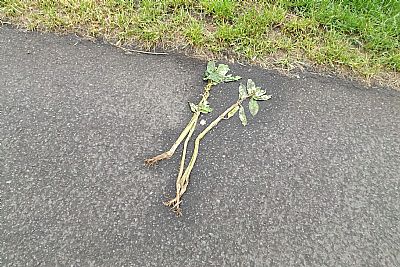
This may be the first time you notice this plant. Someone has ripped on out and discarded it on the towpath. Before long there will be millions of them. The idea of leaving them on the path is so they dry out or rot and the roots cannot remain viable.
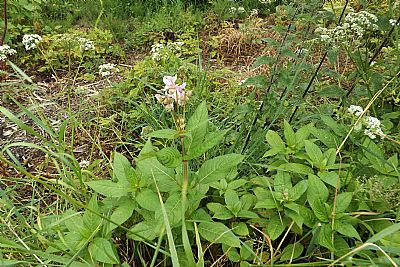
Rather inconspicuous as first and pretty.
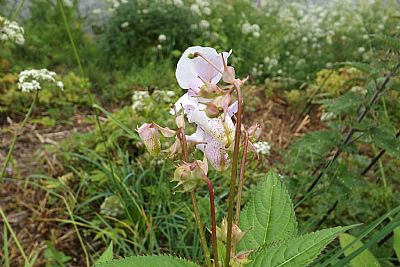
Pale to strong pink flowers.
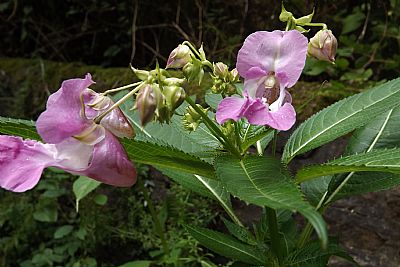
It is not long before large stands of this plant appear. They are very attractive, but that is part of their strategy to get more established.
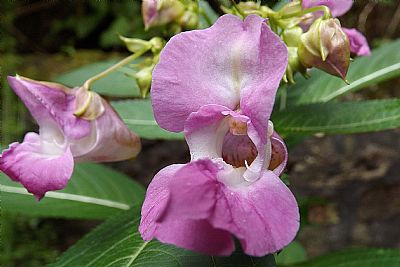
So does this little pretty plant really pose a danger to native species?
Is it futile to pull some out along the towpath or elsewhere? T
As there are no such plants of this size on the west bank of the Leven, it DOES indicate that efforts on that side are having a positive effect. But let's not get complacent.
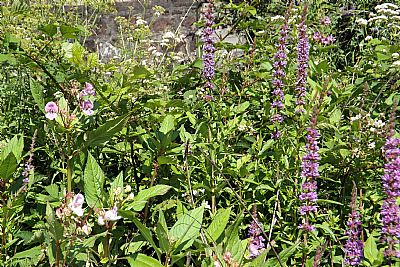
This is the scene on the riverbank of the Leven on the west side in early July. A lovely mix of purple loosestrife, forget-me-not. cow parsley, meadow sweet,purple shamrock, ferns and others seem to be getting on just fine. Over the spring and up to this point flowers have either succeeded each other over the same areas or blended in together. But look closely and you will see that this picturesque blend includes himalayan balsam. Now imagine this very area in a few years time without the curtailment of himalayan balsam. Will it all be overtaken by just this one extensive and large species?
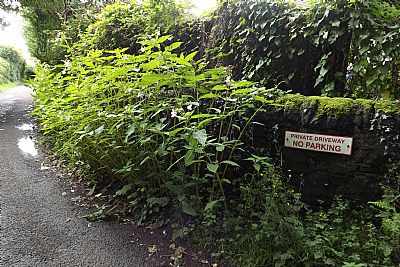
This exhuberant area of himalayan balsam is in Heather Avernue in Alexandria alongside housing.
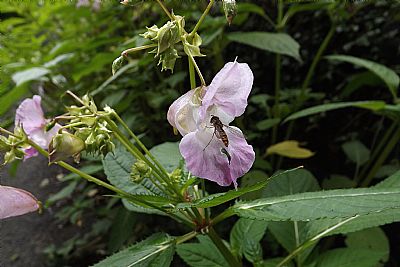
A variety of insects assist with polination and dissemination.
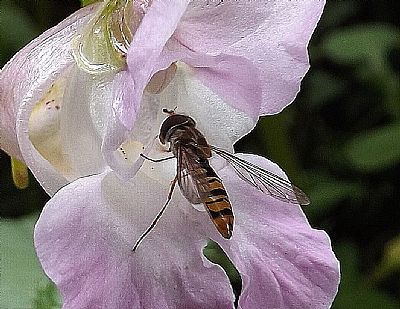
In this case it is hoverfly that is at work.
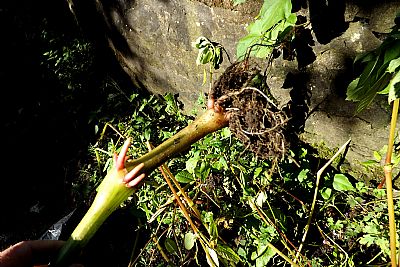
Most plants are easy to pull out. This is what the root system looks like. But look closer and you will see secondary roots already forming - which will form new stems if left alone. While most of the roots will come out when pulled from soft soil, small sections are likely to remain in the soil and beginning as new plants. It is very difficult to stop them without persistent removal.
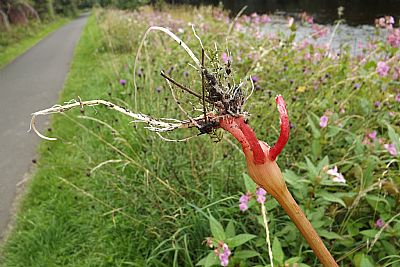
This is even better illustrated in this one which has a mat of thin white roots and above that some underground "branches" intending to creep sideways and develop into a new plant.
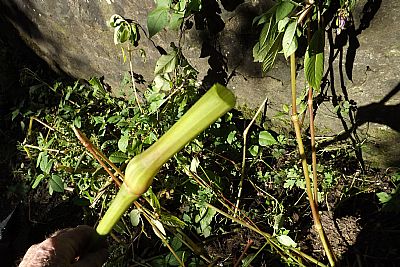
As with other invasive plants (such as Japanese Knotweed),, the stems are hollow. This enables them to grow fast and tall. In the colder months these will die back. But while the plants may look dead and of not further consequence, those roots remain below ground ready to sprout in even greater quantity in the spring.
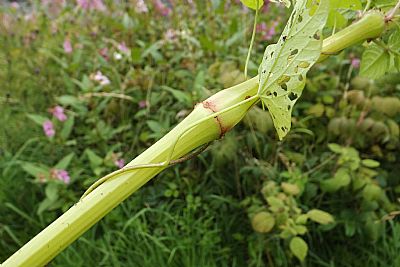
Two invasive plants meet. Some Himalayan Balsam is entined by bindweed. The latter is being eaten by insects and this gives a little control. But the former seems immune to insects or for thatter any other forager.
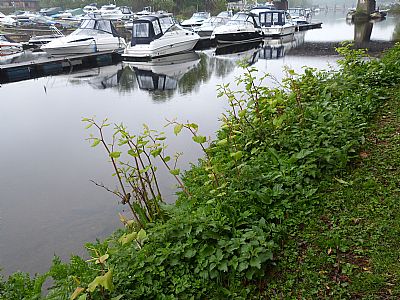
Himalayan balsam has already spread far and wide around our area and beyond, but we still find new locations that it has colonised. Here it is along the upper Leven in late April 2025.
HIMALAYAN BALSAM ELSEWHERE : The problem of its distribution and inevitable ousting or at least out competing of naive species is widespread. Many water courses and road sides around Cardross for instance have every increasing swathes of it.
A prime example of it being out of control is Glasgow where it has settled in in some of the parks - in spite of those being generally well managed. Glasgow has similar problems with plants such as japanese knotweed.
We cannot find a city-wide strategy for it on the Glasgow City Council website, but it falls under a national strategy, both at Scotland and UK levels. You can find a link to a Parliamentary response below. The statement Local action groups, with support from government, are actively involved in reducing and eradicating Himalayan balsam.suggests a lack of actual action at local authority / local government level, instead leaving to locals to handle.
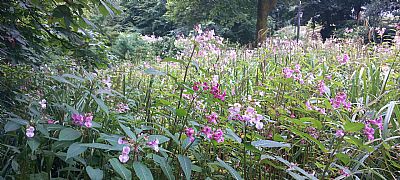
Tolcross Park, Glasgow, July 2024.
CORNWALL COUNCIL : https://www.cornwall.gov.uk/environment/trees-hedges-and-woodlands/invasive-plants/himalayan-balsam/
SCOTTISH INVASIVE SPECIES INITIATIVE : https://www.invasivespecies.scot/index.php/himalayan-balsam
UK PARLIAMENT - Department for Environment, Food and Rural Affairs : https://questions-statements.parliament.uk/written-questions/detail/2017-11-07/HL3026
WILDLIFE TRUSTS : https://www.wildlifetrusts.org/wildlife-explorer/wildflowers/himalayan-balsam

